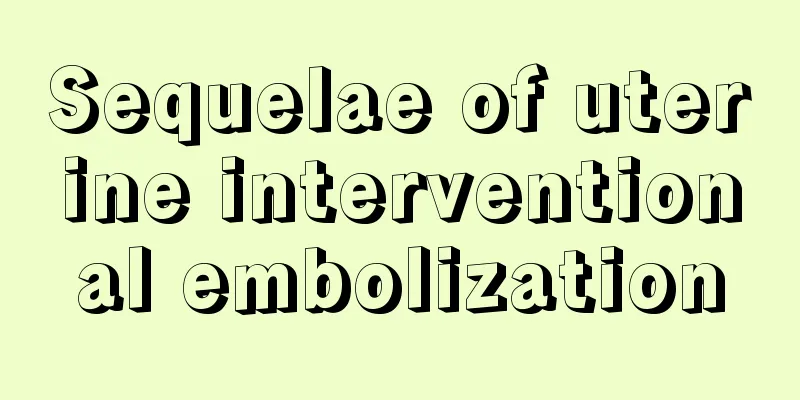Sequelae of uterine interventional embolization

|
Many older women suffer from various gynecological diseases. When there is a problem with the uterus, many people feel embarrassed, so they delay the treatment of the disease. Even a minor problem may become serious. Uterine interventional embolization can treat many uterine diseases. As a very hot topic nowadays, it is recognized by many people. However, any surgery will have some sequelae, and uterine interventional embolization is of course no exception. Surgical treatment includes radical surgery and conservative surgery. Radical surgery is hysterectomy, and conservative surgery includes adenomyosis lesion (adenomyoma) resection, endometrial and myometrial resection, myometrial electrocoagulation, uterine artery occlusion, presacral neurectomy and sacral neurectomy. (1) Hysterectomy It is suitable for patients who have no fertility requirements, have extensive lesions, severe symptoms, and are ineffective with conservative treatment. Moreover, in order to avoid residual lesions, total hysterectomy is the first choice, and partial hysterectomy is generally not advocated. (2) Lesion resection for adenomyosis Suitable for patients who want to have children or young patients. Because adenomyosis often has diffuse lesions and unclear boundaries with the normal uterine muscle tissue, how to choose the method of resection to reduce bleeding, residual tissue and facilitate postoperative pregnancy is a rather difficult problem. Interventional treatment Selective uterine artery embolization can also be used as one of the treatment options for adenomyosis. Its mechanisms of action include: necrosis of the ectopic endometrium, reduced secretion of prostaglandins, relief of dysmenorrhea, reduction of menstrual volume, and lower recurrence rate; establishment of collateral circulation of the endometrium in place, which can gradually migrate and grow from the basal layer to restore function. However, uterine artery embolization will affect the blood supply to the uterus and ovaries, thus having an adverse effect on pregnancy. It may cause infertility, miscarriage, premature birth and increase the rate of cesarean section. Drugs that shrink lesions before surgery and reduce recurrence after surgery. GnRHa injection makes the hormone level in the body reach the menopausal state, thereby causing the ectopic endometrium to gradually atrophy and play a therapeutic role. The application of GnRHa can significantly reduce the size of the uterus and can be used as a preoperative medication for some patients with larger lesions and difficult surgeries. If you wait until the uterus becomes smaller before performing surgery, the risks and difficulty will be significantly reduced. Side effects may cause menopausal symptoms and even serious cardiovascular and cerebrovascular complications and osteoporosis. Therefore, it is recommended to add estrogen in reverse after 3 months of GnRHa application to alleviate complications. In addition, GnRHa is expensive, so it is not currently used as a long-term treatment option. Once the drug is stopped, the resumption of menstruation may lead to further progression of the disease. The above content introduces us to the method of uterine artery embolization. These contents are undoubtedly a great blessing to our patients. We can use the above methods to effectively treat our own problems. We can also tell the above article to our relatives and friends around us, so that more people can recover their health. |
<<: Sequelae of cesarean section anesthesia
>>: Are there any side effects of breast augmentation surgery?
Recommend
#千万IP创科学普# The “combat effectiveness” of autumn mosquitoes is off the charts, beware of dengue fever!
As autumn approaches, some friends have found tha...
What happens if the fetal membrane is not completely expelled?
After every woman becomes pregnant, in addition t...
RivalIQ: Social Media Industry Benchmark Report 2023
RivalIQ released its 2023 Social Media Industry B...
What happens if I take birth control pills during my period?
Emergency contraception is a relatively popular c...
How much is a 711 chocolate milk roll? Is the 711 chocolate milk roll delicious? How does it taste?
As we all know, 711 is a popular convenience stor...
What are the benefits of eating black rice for women
Black bean is a very nutritious whole grain. Alth...
What delicacies can be made with eggs and milk? Why can't ginger be boiled with milk?
Milk is rich in nutrients such as protein, calciu...
What should you pay attention to during confinement? This is scientific!
Women who have gone through the pregnancy and chi...
Pay attention to atrial fibrillation and prevent stroke
Author: Ding Lan, The Second Affiliated Hospital ...
How long after giving birth can I start exercising?
Many mothers often experience deteriorating physi...
If this part of a woman turns black, it must be due to gynecological diseases
As for dark circles under the eyes, most women th...
Why do you urinate frequently before your period?
Many women have such troubles, such as various di...
What to do if bleeding lasts long after medical abortion
Is pregnancy a happy thing or a worrying thing? I...
How can girls exercise to lose weight without growing muscles?
There are many ways for girls to lose weight thro...








![[Popular Science on Epidemic Prevention] Frontline medical staff should pay attention! What should we do if "vicarious trauma" occurs?](/upload/images/67f2538f5d64b.webp)
